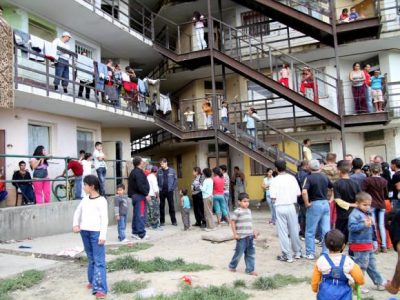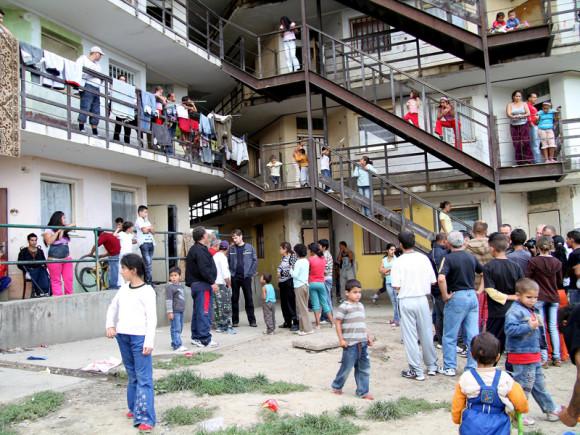
A crowded Roma tenement outside Kosice.
Kosice is not simply one city. Like any Central European metropolis worthy of the name, many urban incarnations coexist cheek and jowl in this charming capital of eastern Slovakia. In the Old Town, a medieval church overlooks a beautifully preserved Renaissance palace that abuts an Art Deco hotel from the Czechoslovak era. The more than a dozen names of the city over the last 800 years – Kaschau, Kassa, Cassow – reflect the many geopolitical convulsions that have reordered the region’s geography. This year, in celebration of its many distinct heritages, Kosice is a European Capital of Culture, along with Marseilles.
The architecture of Kosice’s many cities now forms one harmonious, unified whole. But Kosice contains multiple cities in another, more ominous sense.
Across from Jakab’s Palace, a faux-Gothic castle built in 1899 that also briefly served as the residence of Czechoslovak president Eduard Benes, both locals and tourists sit on the patio of a cafe and drink espresso. There are many such gathering places in Kosice. In the café society of democratic, polyglot Central Europe, spirited discussions take place in Slovak, Czech, Hungarian, English, and many other languages.
Outside the Palace itself, several Roma are having their own meeting. The Gypsies lean against the wall of the building or squat on their haunches. Roma constitute about 6.5 percent of the Slovak population: slightly more than 350,000 people. Kosice has the largest Roma population in Slovakia, nearly 23,000, which is nearly 20 percent of the district’s population. Although the street that separates the café from the grounds of the Palace is very narrow, there is no commerce between the coffee-drinkers and the group of Roma.
Throughout much of Central Europe, there are two cities: for the Roma and for the non-Roma. These cities rarely intersect. During the Communist era, not only did the vast majority of Roma work, as you might expect in a system that espoused full employment. They also interacted at the factories, the farming collectives, the workplace cafeterias, and the bars after work. Today the vast majority of Roma are unemployed. The unemployment for Slovakia as a whole is about 13 percent. In some parts of eastern Slovakia, around Kosice, the unemployment rate for Roma rises to about 80 percent.
I recently travelled to a village 24 kilometers outside of Kosice. More than 90 percent of the residents of Kecerovce are Roma. There’s not much for the several thousand residents of the town to do, other than walk the streets, visit one of the two humble pubs, or shop at the small grocery store.
The Roma social worker in Kecerovce told me that there are virtually no opportunities for the Roma in this countryside village to interact with non-Roma. Some of the better students will eventually make it to Kosice. Thanks to a project funded by outside donors, some Roma youth from Kecerovce have met with non-Roma in both Slovakia and Hungary to participate in trainings, conduct formal debates, and just hang out. Inspired by this project and with the help of the municipality, several young Roma of Kecerovce created a youth center with a book-filled library, a computer, and many after-school activities. The center helps Roma from the village connect with the outside world.
But in Slovakia, as in other parts of the region, this is the exception. In fact, the trend is heading in the other direction. More and more Roma, forced out of the cities by the high price of rent, end up in villages like Kecerovce, in makeshift accommodations and overcrowded houses.
Few non-Roma venture out to these Roma outposts in the countryside, which are becoming more and more homogeneous. Meanwhile, in the big cities like Kosice, non-Roma wander around eating ice cream and viewing the splendors of the Old Town without really ever seeing the Roma. If by chance they do catch sight of Roma, such as the group outside Jakab’s Palace, they quickly look away. The level of anti-Roma sentiment, already high, continues to rise in many countries in the region.
In the novel The City and the City, China Mieville describes two cities, Beszel and Ul Qoma, which occupy the same space in some corner of Central Europe or perhaps the Balkans. The cities occupy a complex checkerboard in which the inhabitants of Beszel can only walk on the black squares, the residents of Ul Qoma on the white ones. Although they share the same topography, they are legally prohibited from interacting even to the point of “unseeing” one another if they pass each other. It would be as if East and West Berlin had existed on top of one another, rather than side by side, with a complex set of rules governing points of contact across the gerrymandered Cold War boundary between them.
This bit of fantasy fiction might sound highly implausible. But in fact, this is the reality for Roma and non-Roma throughout East-Central Europe. Increasingly, the two communities are acculturated into “unseeing” each other. Yes, of course there are exceptions. A Roma elite participates in the larger society. And a few non-Roma – anthropologists, social workers, teachers – navigate the world of the Roma. But despite the Decade of Roma Inclusion, despite millions of dollars, despite many trainings and workshops and conferences and reports, we are confronted with the city and the city: two separate economies, two separate public spaces, two separate realities.
Central Europe has become an Apartheid region where Roma and non-Roma inhabit increasingly separate and decidedly unequal worlds.
Driving between Hungary and Slovakia to visit Kosice, I breezed through the old border station, which was as abandoned and boarded-up as Check Point Charlie had been when I visited Berlin in 1990. The disappearance of borders within the EU has become second nature to the people in the region. For me it still remains breathtaking.
But not all the borders have disappeared within the EU. The one that exists between the city and the city also takes my breath away, but for a very different reason. Sadly, outrageously, this dividing line may prove far more difficult to erase than even the Berlin Wall itself.
